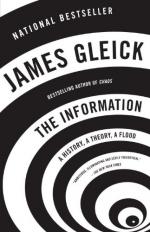
|
| Name: _________________________ | Period: ___________________ |
This test consists of 5 multiple choice questions, 5 short answer questions, and 10 short essay questions.
Multiple Choice Questions
1. In his graduate paper, to what did Claude Shannon apply the binary logic of George Boole?
(a) To a logarithm table.
(b) To a system of relays.
(c) To circuit grid.
(d) To an advanced telegraph.
2. How did people save money in sending telegraph messages?
(a) By compressing the message.
(b) By bribing the operators.
(c) By creating their own code.
(d) By not using it.
3. What code did Claude Shannon apply to relay switches which could either be open or closed?
(a) 0 and 1.
(b) 1 and 100
(c) 2 and 4
(d) .1 to .5
4. What development was the last stage of writing?
(a) Symbolism.
(b) The alphabet.
(c) The numeric system.
(d) Phoenetics.
5. In the prologue to "The Information", what year does Gleick identify as a crucial year in the history of information and computing?
(a) 1961.
(b) 1932.
(c) 1948.
(d) 1955.
Short Answer Questions
1. How many words were contained in "A Table Alphabeticall?"
2. What were the benefits of the early logarithm tables?
3. What was the main form of communication in the late 1940s?
4. What is a bit?
5. Shannon showed that it was theoretically possible to overcome any amount of signal noise by what action?
Short Essay Questions
1. Who developed the Principia Mathematica and what did it provide?
2. Who invented the telegraph and what is its fundamental functionality?
3. What culture developed the earliest known method of writing language with the use of pictures to represent things?
4. How was binary code of 0s and 1s which is the foundation for computing first conceived and by whom?
5. Who invented the "first" telegraph?
6. What are the two "wordbooks" that Gleick refers to in this chapter?
7. How was the "telephone number" born?
8. Who first conceived the idea of a machine that could think and under what circumstances?
9. What were examples of the use of mathematics in the Babylonian culture?
10. In modern times, what innovation has had the most impact on language?
|
This section contains 716 words (approx. 3 pages at 300 words per page) |

|




